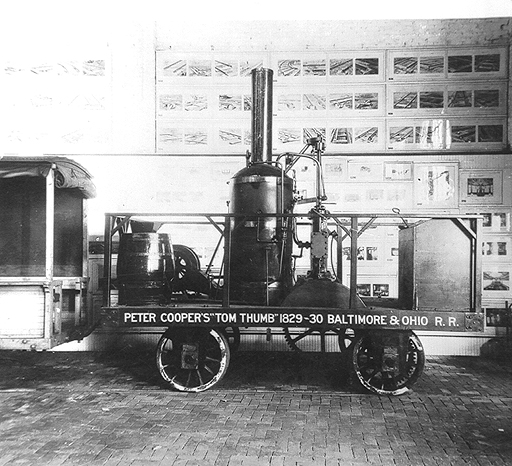
Tom Thumb (locomotive)
Tom Thumb was the first American-built steam locomotive to operate on a common-carrier railroad. It was designed and constructed by Peter Cooper in 1829 to convince owners of the newly formed Baltimore and Ohio Railroad (B&O) (now CSX) to use steam engines; it was not intended to enter revenue service. It is especially remembered as a participant in a legendary race with a horse-drawn car, which the horse won after Tom Thumb suffered a mechanical failure. (See Relay, Maryland.) However, the demonstration was successful, and the railroad committed to the use of steam locomotion and held trials in the following year for a working engine.[2]: 11
Tom Thumb
Steam
Steam
1829
13 ft 2+3⁄4 in (4.03 m)
12 ft 9 in (3.89 m)
27 in × 66 in (690 mm × 1,680 mm)
dia × high
1.4 hp (1.0 kW) horsepower[1]
1.4 hp (1.0 kW) horsepower[1]
Background[edit]
The first railroads were little more than tracks on roads; horses pulled wagons and carriages with their wheels modified to ride on the rails. Trains could not be moved by steam power until the steam engine could be mounted on wheels. The first steam locomotives were built in England, the birthplace of steam power, and the first locomotives in America were imported from England. Soon, however, Americans began to plan their own locomotives.[3]
Design and construction[edit]
Tom Thumb was designed by Peter Cooper as a four-wheel locomotive with a vertical boiler and vertically mounted cylinders that drove the wheels on one of the axles. The "design" was characterized by a host of improvisations. The boiler tubes were made from rifle barrels[2]: 11 and a blower was mounted in the stack, driven by a belt to the powered axle.[2]: 12 [4] The engine was fueled by anthracite coal.[5]
Cooper's interest in the railroad was by way of substantial real estate investment in what is now the Canton neighborhood of Baltimore. Success for the railroad was expected to increase the value of his holdings.[2]: 11
Construction was carried out in the machine shop of George W. Johnson, where the 18-year-old James Millholland was apprenticed.[6] Millholland would later become a prominent locomotive designer in his own right.